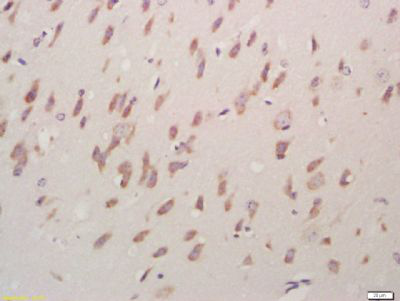产品货号 : mlR4915
英文名称 : ACCN1
中文名称 : 脑钠通道蛋白1抗体
别 名 : ACCN; ASIC2a; BNaC1; ASIC2; ASICs2 ACCN1_HUMAN; Acid sensing ion channel 2; Acid-sensing ion channel 2; Amiloride sensitive brain sodium channel; Amiloride sensitive cation channel 1 neuronal (degenerin); Amiloride sensitive cation channel 1 neuronal; Amiloride-sensitive brain sodium channel; Amiloride-sensitive cation channel 1, neuronal; Amiloride-sensitive cation channel neuronal 1; ASIC2; ASIC2a; BNaC1; Brain sodium channel 1; Degenerin; hBNaC1; Mammalian degenerin homolog; MDEG; Neuronal amiloride sensitive cation channel 1.
研究领域 : 细胞生物 免疫学 神经生物学 通道蛋白 淋巴细胞 t-淋巴细胞
抗体来源 : Rabbit
克隆类型 : Polyclonal
交叉反应 : Human, Mouse, Rat, Dog, Cow, Horse, Rabbit,
产品应用 : WB=1:500-2000 ELISA=1:500-1000 IHC-P=1:400-800 IHC-F=1:400-800 ICC=1:100-500 IF=1:100-500 (石蜡切片需做抗原修复)
not yet tested in other applications.
optimal dilutions/concentrations should be determined by the end user.
分 子 量 : 56kDa
细胞定位 : 细胞浆 细胞膜
性 状 : Lyophilized or Liquid
浓 度 : 1mg/ml
免 疫 原 : KLH conjugated synthetic peptide derived from human ACCN1:301-400/512 <Extracellular>
亚 型 : IgG
纯化方法 : affinity purified by Protein A
储 存 液 : 0.01M TBS(pH7.4) with 1% BSA, 0.03% Proclin300 and 50% Glycerol.
保存条件 : Store at -20 °C for one year. Avoid repeated freeze/thaw cycles. The lyophilized antibody is stable at room temperature for at least one month and for greater than a year when kept at -20°C. When reconstituted in sterile pH 7.4 0.01M PBS or diluent of antibody the antibody is stable for at least two weeks at 2-4 °C.
PubMed : PubMed
产品介绍 : Degenerin/epithelial sodium channel (DEG/ENaC) superfamily members are amiloride-sensitive sodium channels that contain intracellular N- and C-termini, 2 two hydrophobic transmembrane regions and a cysteine-containing extracellular loop. Acid sensing ion channel ASIC1, also designated ACCN2, BNAC2 and ASIC1a, is present in brain as a 4.3-kb transcript with localization to rat dorsal root ganglia. In situ hybridization of rat brain suggests that ASIC1 is most abundant in the main olfactory bulb, cerebral cortex, hippocampal formation, habenula, basolateral amygdaloid nuclei and cerebellum. ASIC1 and H+-gated currents may contribute to the development of fear and anxiety. ASIC2, also designated amiloride-sensitive cation channel 1, neuronal (ACCN1), mammalian degenerin, BNAC1 (MDEG) and brain Na+ channel 1, mediates the normal detection of light touch. ASIC2 mRNA is abundant in brain, specifically in neurons. ASIC2 is expressed as 2.7- and 3.7-kb transcripts in brain and spinal cord tissues. ASIC3, also designated ASIC3, SLNAC1 and TNaC1, mediates detection of lasting pH changes and is involved in modulating moderate- to high-intensity pain sensation. ASIC4, also designated ACCN4 and BNAC4, is abundant in pituitary gland and is also present in the inner ear.
Function:
Cation channel with high affinity for sodium, which is gated by extracellular protons and inhibited by the diuretic amiloride. Also permeable for Li(+) and K(+). Generates a biphasic current with a fast inactivating and a slow sustained phase. Heteromeric channel assembly seems to modulate.
Subcellular Location:
Cell membrane. Localized at the plasma membrane of neurons, in the soma and punctated peripheral processes.
Tissue Specificity:
Brain and spinal cord. Isoform 1 is also detected in testis, liver, colon and ovary.
Similarity:
Belongs to the amiloride-sensitive sodium channel (TC 1.A.6) family. ACCN1 subfamily.
SWISS:
Q16515
Gene ID:
40
Important Note:
This product as supplied is intended for research use only, not for use in human, therapeutic or diagnostic applications.
产品图片












